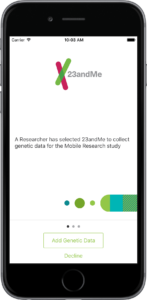For fans of HBO’s hit show Silicon Valley, you may be familiar with this formula for innovation – put a bunch of smart

Mike Polcari, a 23andMe vice president and its chief architect, lays out the schedule on the first day of the hackathon.
people together in a room and give them 48 hours, with the freedom to pursue their own ideas, and raise the stakes with a little friendly competition.
This formula is known as a “hackathon”– focused design sprints that involve engineers, scientists, designers, product managers and others. It’s an event we’ve embraced annually at 23andMe, where the hackathons have helped spawn new products and novel ideas.
“My hope with the hackathon was manifold – to foster innovation within the building, get everyone thinking about exciting opportunities to deliver new ideas to the customer, to get people to break out of their routine, and to get them to collaborate with different people on something they’re passionate about,” said Mike Polcari, our VP, Chief Architect.
This year’s 23andMe hackathon didn’t disappoint, with groups developing everything from a simple way to track the progression of Parkinson’s by using a patient’s own phone, to creating an online tool to see what traits you and your partner might pass onto your baby, to integrating 23andMe’s phenotypic data collection into  Apple’s open source ResearchKit ®framework.
Apple’s open source ResearchKit ®framework.
Earlier this month, 23andMe-ers from across the company assembled into teams centered on a variety of ideas. Some let out their inner artists, focusing on ways to artistically represent genetic information. Others proposed ways to take a deeper dive into 23andMe’s existing database, finding opportunities to offer customers more information with results.
While some got down and dirty with the microbes found in your mouth (did you know that as much as 10 percent of the DNA found in your saliva isn’t human!?), all of the teams shared the same goal, to create something new and useful for 23andMe customers.
For most participants, this was a chance to push aside some of their day-to-day workload and to develop long-time passion projects.
“I’ve had this idea for a while and felt that the hackathon was the right opportunity to get some momentum and bring the idea to fruition,” said Olga Sazonova, a 23andMe computational biologist.
Olga worked on an idea to extract microbiome data from saliva. Her idea would then use the information gleaned from the microbiome data to add to what customers can already learn about themselves from the DNA that is extracted from their spit.
Another scientist, who worked with a team on a hack he called “super color sensor,” meant to detect if a customer could see small variations in color shades, said he’d been thinking about this idea even before his time at 23andMe. The freedom of the hackathon gave him an opportunity to see if he could bring this idea to life.

As part of the two-day hackathon, a team working on a new app for educators map out ideas and the flow of the design on post-it notes.
Whether the teams were successful or not, the process was also about collectively energizing the company, so that when everyone goes back to their routine work they can apply that same level of passion and focus.
Although the winning prize of a fancy dinner in downtown Mountain View certainly enticed our hackers to bring their projects to life over this short window of time (and a company-wide rooftop Happy Hour at the conclusion didn’t hurt either), the real prize is producing something that not only the employees at 23andMe can explore, but one that can help our customers in some way.
This year, three of the 24 different projects rose to the top: one that further integrates 23andMe’s collection of data for research into Apple’s open source ResearchKit* framework; another one focused on diet; and the third one that includes an interactive map of the human body to allow customers to see parts of the body for which 23andMe offers reports.
Reflecting on all the different ideas developed in this year’s hackathon, Mike said he was impressed.
“People found that having this kind of ownership over the end product was engaging, motivating, and exhausting,” he said. “But also the most fun they’ve had. There’s something magical about offering people the autonomy, creative license and control that makes our hackathon an unparalleled opportunity for real innovation.”
*ResearchKit is a registered trademark of Apple Inc.



